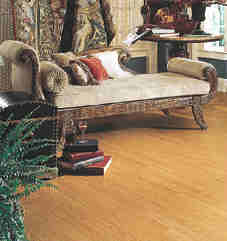Exceptional Durability!
Do you want the beautiful appearance of a real hardwood floor
but with exceptional performance that will holdup from the wear and tear
from kids,
pets, and spills? This question is in the minds of many American
homeowners when shopping for a new floor. The answer many flooring shoppers
have found
is choosing one of the many laminate floors. These floors are
similar in construction to the laminate kitchen counter tops but with
some added performance
features.
Laminate floors originally came from Europe where they have
been used in homes for over 20 years. Although most of the laminate floors
are imported, a few of the laminate brands are made here in the U.S.A..
The performance differences between the brands appears to be minor even
though the construction methods that are used may be slightly different.
All the laminate floors have good performance characteristics and are often
confused with real hardwood floors. Even though these floors resemble real
wood floors they are not wood. Our cross-section diagram of a laminate
floor should help you better understand the differences between wood and
laminates.
Laminate floors offer many benefits for homeowners, including:
- Exceptional durability
- Easy to clean surface
- Superior stain resistance
- Superior fade resistance
- Install in on all grade levels, even below grade
- Install over many different types of subfloors
- Great impact and indentation resistance
- Exceptional realism at affordable costs
- Easy to replace later on, if desired.
Laminate flooring is a tongue and groove interlocking flooring system that comes in either planks or squares. All of these floors have a wearlayer, a decorative print film layer, an inner core structure, and some type of backing support layer. The decorative print film layer is either fused or glued to the inner core. The print film can be a photo of any real floor. The wearlayer is applied to the decorative print layer to protect the pattern. Melamine resins are the main component of the wearlayer. The melamine surface gets its incredible durability from aluminum oxide. Aluminum oxide is almost as hard as diamonds and provides unsurpassed wear and stain resistance.
Backing - is usually a melamine plastic layer used to
give additional structural stability and added moisture protection
to the planks.
Core - generally made from high-density fiber board (HDF), particle
board, or plastic, the core adds impact resistance, and forms
the tongue and groove locking system. Melamine plastic resins
are also impregnated in the core by some of the manufacturers
to improve the moisture resistance of the core.
Melamine - is a plastic-type resin used throughout the construction
process to add durability, and stability to the laminated planks.
Print Film - which is also called the decorative layer gives
the floor the appearance of a real hardwood or tile. Some manufacturers
have been able to duplicate the old wood floors found only in
some old historical buildings.
Wearlayer - is a tough clear melamine layer with aluminum oxide
particles. When fused together with heat and direct pressure
to the core the wearlayer becomes an incredibly hard, durable
finish. The resin-filled wearlayer is so dense it becomes extremely
difficult to stain, scratch, or burn.
Underlayment - is a clear thin plastic sheet that is installed
over the substrate before the laminate floor is floated. The
plastic sheet helps the laminate floor to float freely above
the substrate.
 Atlanta Flooring Design sells and installs Laminates
Atlanta Flooring Design sells and installs Laminates
Atlanta
Flooring Design Centers features Alloc, Pergo, Formica,Wilsonart,
Mohawk, and Mannington laminate products. Industry wide, Laminate
sales have increased by leaps and bounds since it was first introduced
in 1994.
It is estimated that this category of floor covering increased
at the greatest rate in 1998. This is also a very exciting
product line for Southern Rug. The success of this product
is due to its real wood look and the fact that it can be installed
quickly, with an already finished look (no sanding required).
